2018 PEUGEOT 5008 belt
[x] Cancel search: beltPage 140 of 364
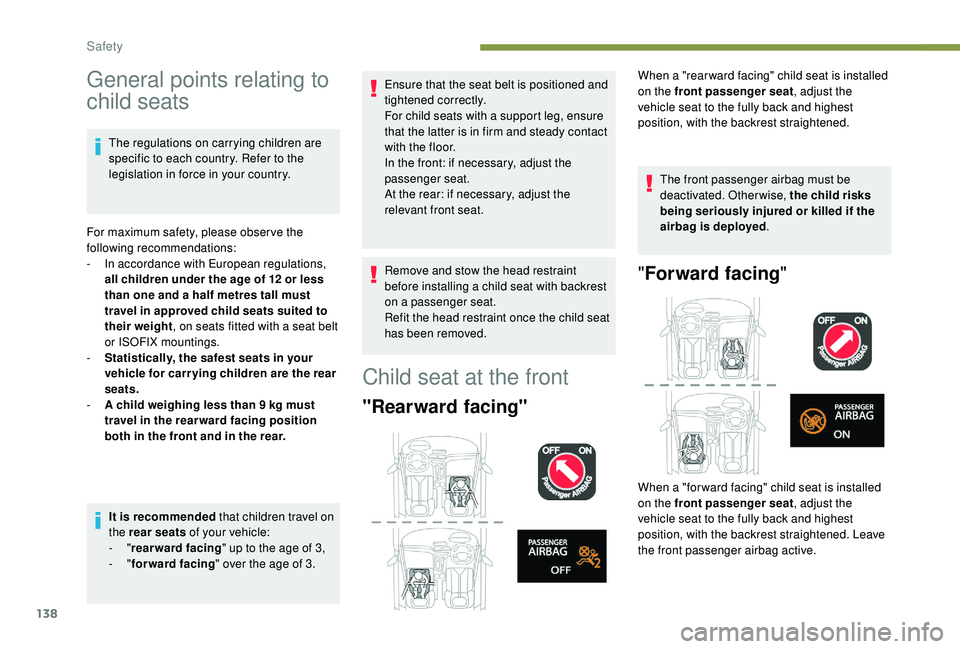
138
General points relating to
child seats
The regulations on carrying children are
specific to each country. Refer to the
legislation in force in your country.
For maximum safety, please obser ve the
following recommendations:
-
I
n accordance with European regulations,
all children under the age of 12
or less
than one and a
half metres tall must
travel in approved child seats suited to
their weight , on seats fitted with a
seat belt
or ISOFIX mountings.
-
S
tatistically, the safest seats in your
vehicle for carr ying children are the rear
seats.
-
A c
hild weighing less than 9 kg must
travel in the rear ward facing position
both in the front and in the rear.
It is recommended that children travel on
the rear seats of your vehicle:
-
"rearward facing " up to the age of 3,
-
"forward facing " over the age of 3. Ensure that the seat belt is positioned and
tightened correctly.
For child seats with a
support leg, ensure
that the latter is in firm and steady contact
with the floor.
In the front: if necessary, adjust the
passenger seat.
At the rear: if necessary, adjust the
relevant front seat.
Remove and stow the head restraint
before installing a
child seat with backrest
on a
passenger seat.
Refit the head restraint once the child seat
has been removed.
Child seat at the front
"Rearward facing"
When a "rear ward facing" child seat is installed
o n the front passenger seat , adjust the
vehicle seat to the fully back and highest
position, with the backrest straightened.
The front passenger airbag must be
deactivated. Otherwise, the child risks
being seriously injured or killed if the
airbag is deployed .
"Forward facing "
When a "for ward facing" child seat is installed
on the front passenger seat , adjust the
vehicle seat to the fully back and highest
position, with the backrest straightened. Leave
the front passenger airbag active.
Safety
Page 144 of 364

142
Child seat at the rear
"Rearward facing "
" Forward facing "
When a "for ward facing" child seat is installed
on a
rear passenger seat , move the vehicle's
front seat for ward and straighten the backrest
so that the legs of the child in the "for ward
facing" child seat do not touch the vehicle's
front seat.
Recommended child
seats
Range of recommended child seats which are
secured using a three-point seat belt .
When a "rear ward facing" child seat is installed
on a
rear passenger seat
, move the vehicle's
front seat for ward and straighten the backrest
so that the "rear ward facing" child seat does
not touch the vehicle's front seat. In the presence of a dog guard, it is
imperative that children's booster seats
with backrest be installed in the second
row. Group 0+: from bir th to 13 kg
L1
"RÖMER Baby-Safe Plus"
Installed in the "rearward facing" position.
Groups 2 and 3: from 15 to 36 kg
L5
"RÖMER KIDFIX"
Can be fitted to the vehicle's ISOFIX mountings.
The child is restrained by the seat belt.
Safety
Page 145 of 364
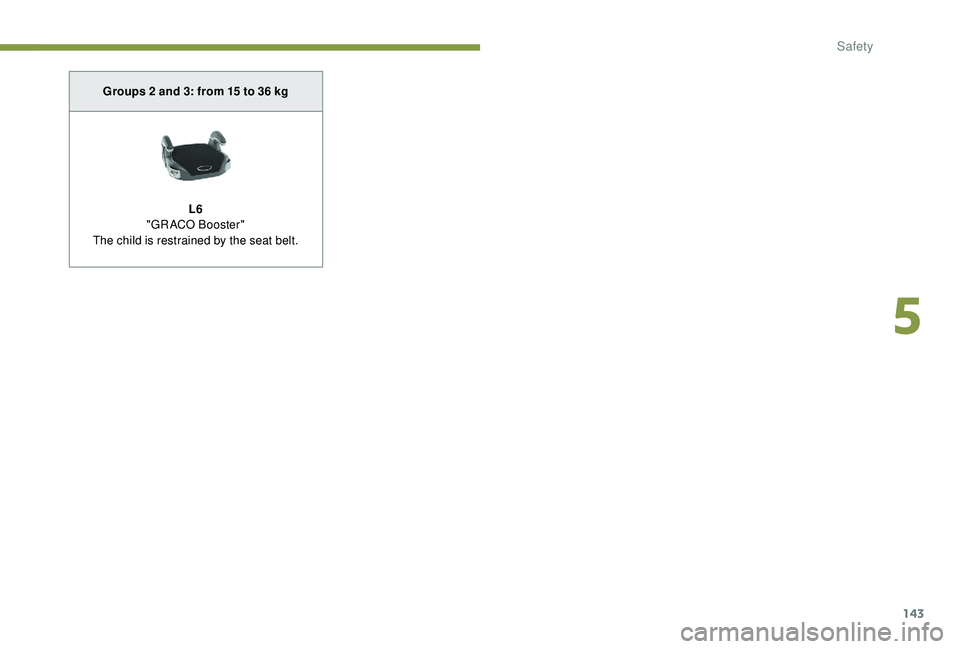
143
Groups 2 and 3: from 15 to 36 kg
L 6
"GRACO Booster"
The child is restrained by the seat belt.
5
Safety
Page 146 of 364
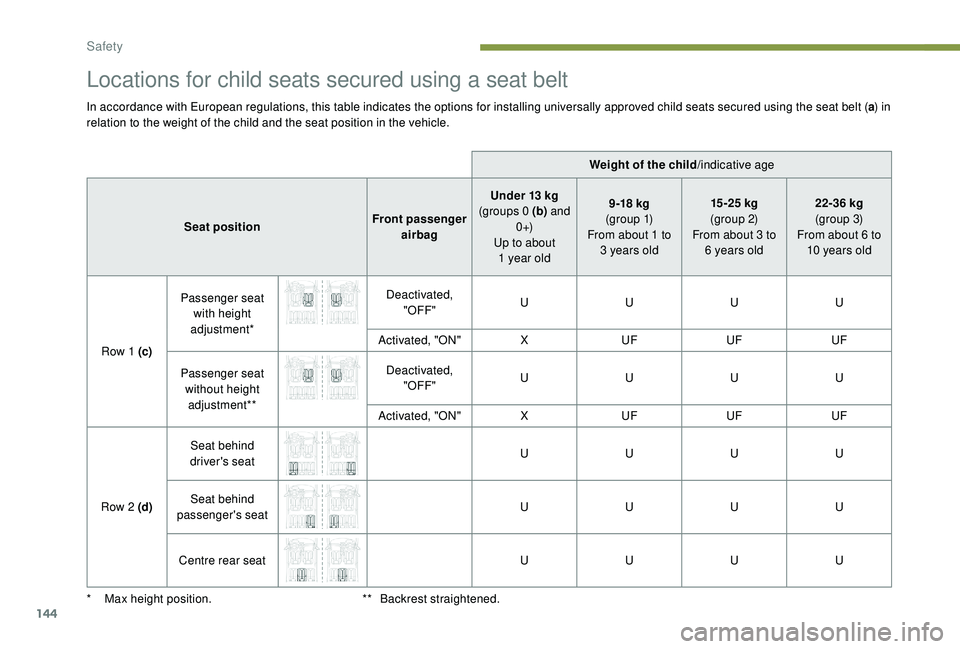
144
Locations for child seats secured using a seat belt
In accordance with European regulations, this table indicates the options for installing universally approved child seats secured using the seat belt (a) in
relation to the weight of the child and the seat position in the vehicle.
Weight of the child/indicative age
Seat position Front passenger
airbag Under 13
kg
(groups 0 (b) and
0 +)
Up to about 1
year old9 -18
kg
(g r o u p 1)
From about 1
to
3
years old15 -25
kg
(group 2)
From about 3
to
6
years old22-36
kg
(group 3)
From about 6
to
10
years old
Row 1 (c) Passenger seat
with height
adjustment* Deactivated,
"OFF" U
UUU
Activated, "ON" XUF UFUF
Passenger seat without height adjustment** Deactivated,
"OFF" U
UUU
Activated, "ON" XUF UFUF
Row 2 (d) Seat behind
driver's seat U
UUU
Seat behind
passenger's seat U
UUU
Centre rear seat UUUU
*
M
ax height position. **
B
ackrest straightened.
Safety
Page 147 of 364
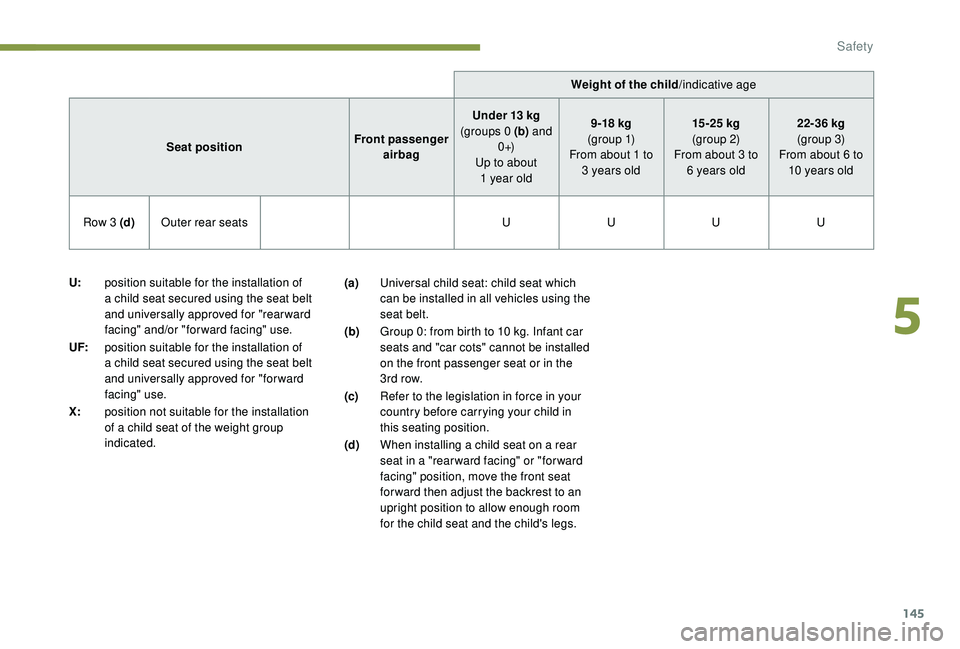
145
(a)Universal child seat: child seat which
can be installed in all vehicles using the
seat belt.
(b) Group 0: from birth to 10
kg. Infant car
seats and "car cots" cannot be installed
on the front passenger seat or in the
3rd row.
(c) Refer to the legislation in force in your
country before carrying your child in
this seating position.
(d) When installing a
child seat on a rear
seat in a
"rear ward facing" or "for ward
facing" position, move the front seat
for ward then adjust the backrest to an
upright position to allow enough room
for the child seat and the child's legs.
U:
position suitable for the installation of
a
child seat secured using the seat belt
and universally approved for "rearward
facing" and/or "forward facing" use.
UF: position suitable for the installation of
a
child seat secured using the seat belt
and universally approved for "forward
facing" use.
X: position not suitable for the installation
of a
child seat of the weight group
indicated. Weight of the child
/indicative age
Seat position Front passenger
airbag Under 13 kg
(groups 0 (b) and
0 +)
Up to about 1 year old
9 -18
kg
(g r o u p 1)
From about 1 to
3 years old
15 -25
kg
(group 2)
From about 3 to
6 years old
22-36 kg
(group 3)
From about 6 to
10 years old
Row 3 (d) Outer rear seats UUUU
5
Safety
Page 148 of 364
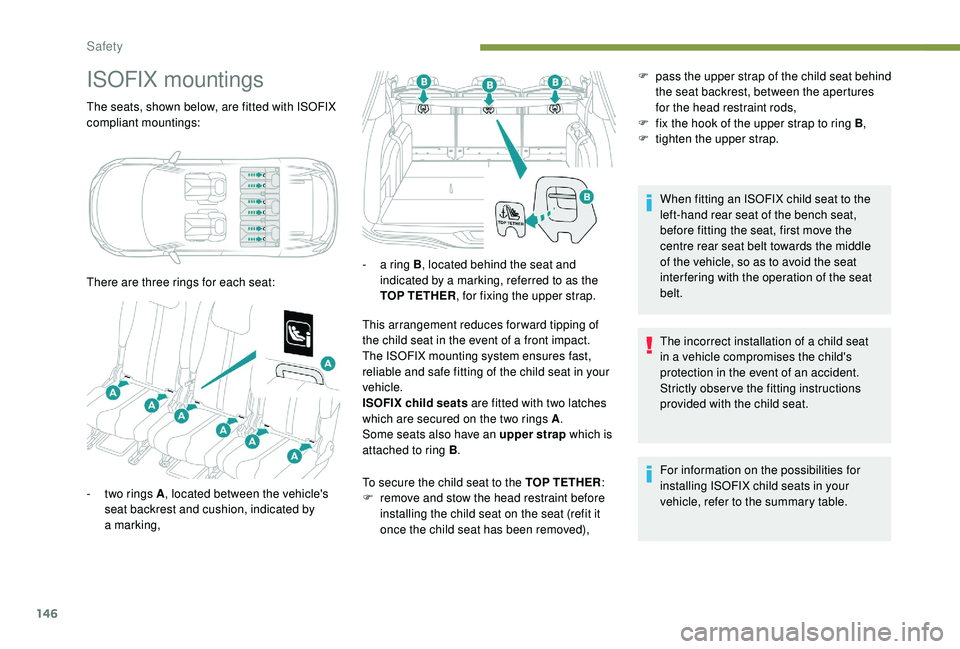
146
ISOFIX mountings
The seats, shown below, are fitted with ISOFIX
compliant mountings:
There are three rings for each seat:This arrangement reduces forward tipping of
the child seat in the event of a
front impact.
The ISOFIX mounting system ensures fast,
reliable and safe fitting of the child seat in your
vehicle.
ISOFIX child seats are fitted with two latches
which are secured on the two rings A .
Some seats also have an upper strap which is
attached to ring B . F
p
ass the upper strap of the child seat behind
the seat backrest, between the apertures
for the head restraint rods,
F
f
ix the hook of the upper strap to ring B,
F
t
ighten the upper strap.
When fitting an ISOFIX child seat to the
left-hand rear seat of the bench seat,
before fitting the seat, first move the
centre rear seat belt towards the middle
of the vehicle, so as to avoid the seat
interfering with the operation of the seat
belt.
The incorrect installation of a
child seat
in a
vehicle compromises the child's
protection in the event of an accident.
Strictly obser ve the fitting instructions
provided with the child seat.
For information on the possibilities for
installing ISOFIX child seats in your
vehicle, refer to the summary table.
-
t
wo rings A , located between the vehicle's
seat backrest and cushion, indicated by
a
marking, -
a r
ing B, located behind the seat and
indicated by a
marking, referred to as the
TOP TETHER , for fixing the upper strap.
To secure the child seat to the TOP TETHER :
F
r
emove and stow the head restraint before
installing the child seat on the seat (refit it
once the child seat has been removed),
Safety
Page 149 of 364
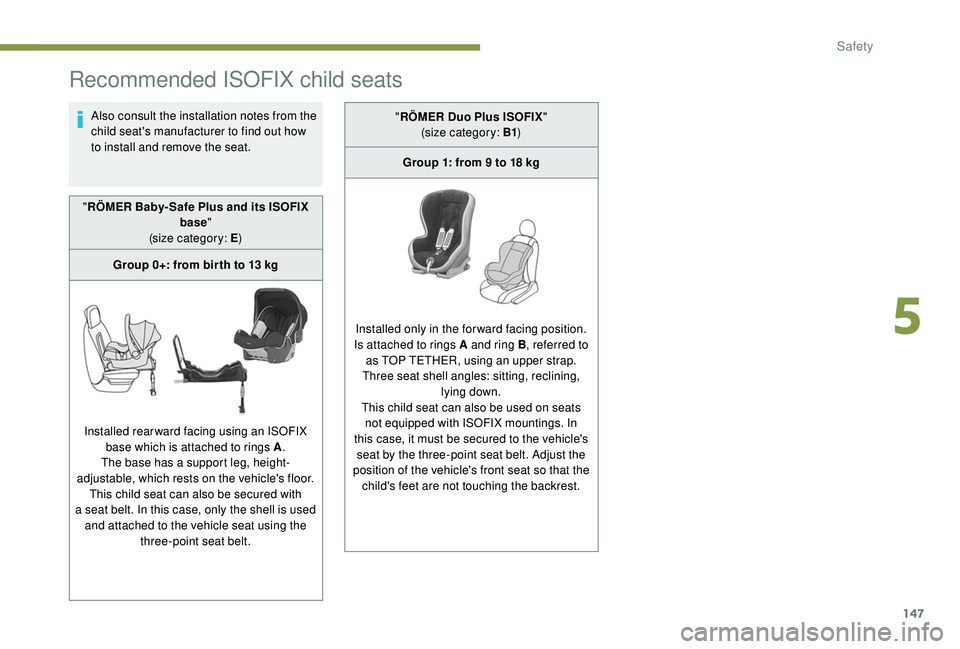
147
Recommended ISOFIX child seats
Also consult the installation notes from the
child seat's manufacturer to find out how
to install and remove the seat.
" RÖMER Baby- Safe Plus and its ISOFIX
base"
(size category: E )
Group 0+: from bir th to 13
kg
Installed rearward facing using an ISOFIX base which is attached to rings A .
The base has a
support leg, height-
adjustable, which rests on the vehicle's floor. This child seat can also be secured with
a
seat belt. In this case, only the shell is used
and attached to the vehicle seat using the three-point seat belt. "
RÖMER Duo Plus ISOFIX "
(size category: B1 )
Group 1: from 9 to 18 kg
Installed only in the forward facing position.
Is attached to rings A and ring B , referred to
as TOP TETHER, using an upper strap.
Three seat shell angles: sitting, reclining, lying down.
This child seat can also be used on seats not equipped with ISOFIX mountings. In
this case, it must be secured to the vehicle's seat by the three-point seat belt. Adjust the
position of the vehicle's front seat so that the child's feet are not touching the backrest.
5
Safety
Page 154 of 364

152
The incorrect installation of a child seat in
a vehicle compromises the child's protection
in the event of an accident.
Ensure that there is no seat belt or seat belt
buckle under the child seat, as this could
destabilise it.
Remember to fasten the seat belts or the
child seat harnesses keeping the slack
relative to the child's body to a
minimum,
even for short journeys.
When installing a
child seat using the seat
belt, ensure that the seat belt is tightened
correctly on the child seat and that it secures
the child seat firmly on the seat of your
vehicle. If your passenger seat is adjustable,
move it for wards if necessary.
At rear seating positions, always leave
sufficient space between the front seat and:
-
a r
ear ward facing child seat,
-
t
he child's feet for a child seat fitted
forward facing.
To do this, move the front seat for wards
and, if necessary, move its backrest into the
upright position.
For optimal installation of the forward facing
child seat, verify that its backrest is as close
as possible to the backrest of the vehicle
seat, if possible in contact with it. The head restraint must be removed before
installing a
child seat with a backrest on
a
passenger seat.
Ensure that the head restraint is stored or
attached securely to prevent it from being
thrown around the vehicle in the event of
sharp braking. Refit the head restraint when
the child seat is removed. As a
safety precaution, do not leave:
- a c hild or children alone and unattended in
a
vehicle,
-
a c
hild or an animal in a vehicle which
is exposed to the sun, with the windows
closed,
-
t
he keys within reach of children inside the
vehicle.
To prevent accidental opening of the doors
and rear windows, use the child lock.
Take care not to open the rear windows by
more than one third.
To protect young children from the rays of the
sun, fit side blinds on the rear windows.
Advice
Children in front
The legislation on carrying children on the
front passenger seat is specific to each
country. Refer to the legislation in force in
your country.
Deactivate the front passenger airbag when
a
rear ward facing child seat is installed on the
front passenger seat.
Otherwise, the child would risk being
seriously injured or killed if the airbag were
deployed.
Installing a
booster seat
The chest part of the seat belt must be
positioned on the child's shoulder without
touching the neck.
Ensure that the lap part of the seat belt
passes correctly over the child's thighs.
PEUGEOT recommends using a
booster seat
with a
backrest equipped with a belt guide at
shoulder level.
Safety